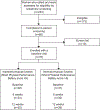Examining the Role of Nonsurgical Therapy in the Treatment of Geriatric Urinary Incontinence
- PMID: 35852275
- PMCID: PMC9502119
- DOI: 10.1097/AOG.0000000000004852
Examining the Role of Nonsurgical Therapy in the Treatment of Geriatric Urinary Incontinence
Abstract
Objective: To examine the role of physical function impairments on the change in urinary incontinence (UI) symptoms after pelvic floor muscle training in older women.
Methods: This is a prospective cohort study of 70 community-dwelling participants, older than age 70 years, with at least moderate incontinence symptoms. A comprehensive pelvic floor and physical function assessment was done at baseline. Individualized pelvic floor muscle training prescriptions with behavioral management strategies to reduce incontinence episodes were provided for 12 weeks. Baseline physical function was determined using the SPPB (Short Physical Performance Battery). A total score of 9 or lower out of 12 indicated impaired physical function, and scores higher than 9 indicated normal physical function. A 3-day bladder diary established daily incontinence episodes. The between-group difference in the change in number of UI episodes, from baseline to 6 weeks, was our primary outcome. Descriptive analyses compared important demographic and clinical characteristics. Longitudinal mixed model linear regression analyses determined the change in incontinence episodes and estimates of improvement based on the presence of impaired physical function and adjusted for age, race, and body mass index (BMI).
Results: Participants' mean±SD age was 76.9±5.4 years, and 15.7% identified as African American, with no significant differences in age or race between groups. Participants with impaired physical function had higher mean±SD BMI (33.6±14.5 vs 27.4±5.8; P=.03) and more baseline incontinence episodes (4.5±2.9 vs 2.7±2.1 episodes per day; P=.005) than in women without functional impairment. After 6 weeks of pelvic floor exercises, the change in number of incontinence episodes per day was not different between participants with physical functional impairment compared with women with normal physical function (mean [95% CI] -1.2 [-2.0 to -0.5] vs -0.4 [-1.1 to 0.3], P=.31). Overall, after 12 weeks of pelvic floor muscle training, complete satisfaction with incontinence symptom improvement was low for both groups (41.8% with physical function impairments vs 44.8% with normal physical function; P=.90).
Conclusion: Behavioral therapy including pelvic floor muscle training may not significantly decrease UI symptoms to a degree that is satisfactory in women who are older than 70 years and are seeking treatment for UI, regardless of the presence of physical function impairments.
Clinical trial registration: ClinicalTrials.gov, NCT03057834.
Copyright © 2022 by the American College of Obstetricians and Gynecologists. Published by Wolters Kluwer Health, Inc. All rights reserved.
Conflict of interest statement
Financial Disclosure Catherine A. Matthews disclosed that money was paid to her institution from Boston Scientific and Neomedic. She received funding from Boston Scientific and has been an expert witness for Ethicon. The other authors did not report any potential conflicts of interest.
Figures
References
-
- Tinetti ME, et al., Shared risk factors for falls, incontinence, and functional dependence. Unifying the approach to geriatric syndromes. JAMA, 1995. 273(17): p. 1348–53. - PubMed
-
- Laycock J. and Jerwood D, Pelvic floor muscle assessment: the PERFECT scheme. Physiotherapy, 2001. 87(12): p. 631–642.
-
- Abrams P, et al., 6th International Consultation on Incontinence. Recommendations of the International Scientific Committee: EVALUATION AND TREATMENT OF URINARY INCONTINENCE, PELVIC ORGAN PROLAPSE AND FAECAL INCONTINENCE. Neurourol Urodyn, 2018. 37(7): p. 2271–2272. - PubMed


